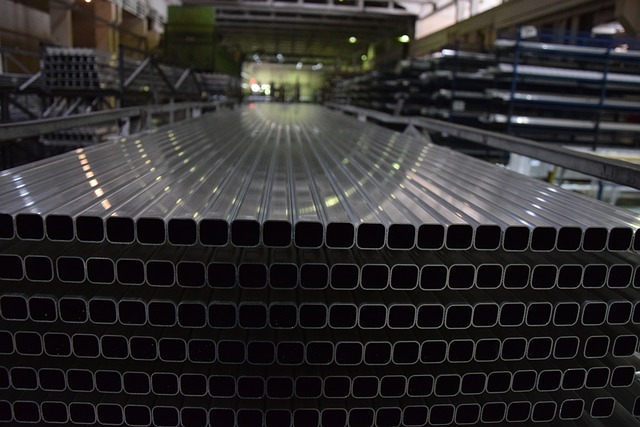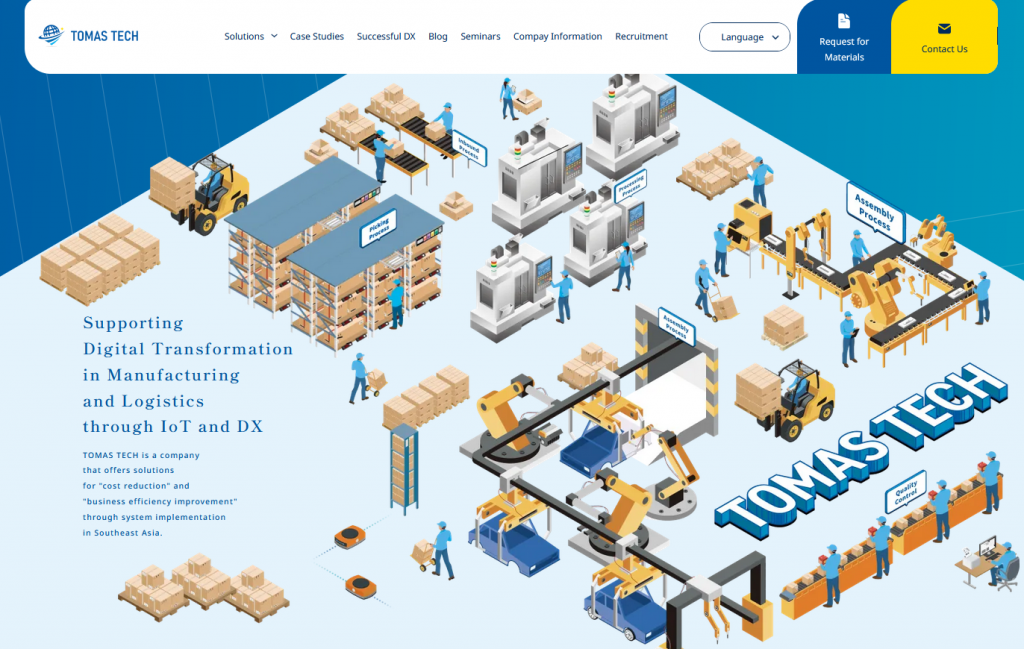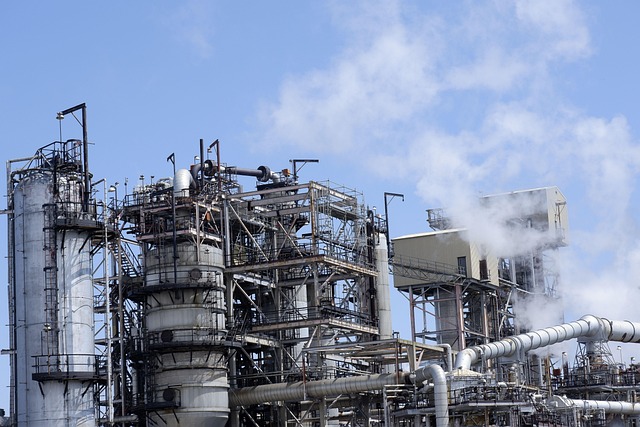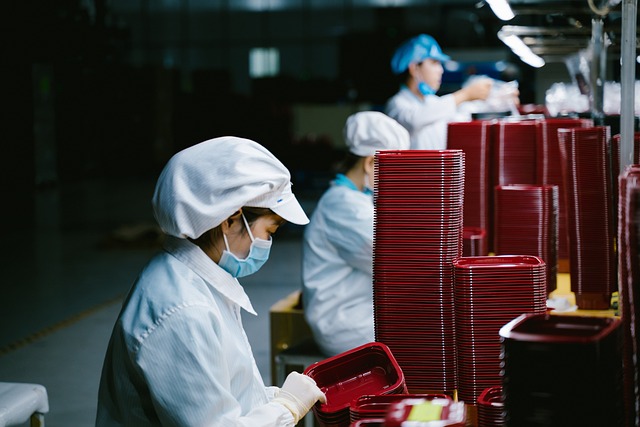The problem faced by companies with manufacturing bases in Thailand is that it is difficult to see the site, such as “invisible progress”, “complicated management on paper”, and “it does not continue even if it is improved”.
TOMASTECH has been helping to solve these fundamental issues through support such as MES introduction, process traceability, and human resource development.
In this article, we will introduce the steps to successfully improve the site of the Thai manufacturing industry and the specific support provided by TOMASTECH.
What can be done to improve productivity in Thailand’s manufacturing industry

From here, we will explain in detail TOMASTECH’s approach to visualizing issues in the field.
Real-time grasp of progress, defects, and equipment operation
To improve productivity at the manufacturing site, it is essential to have a system that can accurately grasp what is happening now.
By being able to check the progress, defect status, and equipment operating status in real time, delays and problems can be immediately responded to, leading to minimization of production losses.
In recent years, there has been a movement to introduce manufacturing execution systems (MES) to automatically collect and visualize data on the field.
A major advantage is that it is possible to make decisions based on real-time data without relying on daily reports or oral reports.
Creating a system to prevent on-site work from becoming individualized
When the work depends on a specific person, resignation or transfer is a big risk.
To prevent individualization, it is important to clarify work procedures and create a system that allows anyone to work with a certain quality.
By developing standard work manuals and video manuals, and visualizing work processes, we can reduce variations due to differences in skill.
In addition, through the sharing of records and the conversion of data, it is easier to eliminate the information gap between sites.
Improving operational efficiency by moving away from paper forms
Paper records and reports carry the risk of errors or losses, and it takes time and effort to tally them.
These paper forms are often a hindrance to productivity gains.
In recent years, more and more companies have been able to input check sheets and daily reports on tablets and PCs, allowing them to share and analyze data in real time.
The effects are wide-ranging, such as preventing input errors, automating aggregation work, and reducing the workload on the site.
Digitalization is a great way to improve both operational efficiency and quality.
Improving productivity and operations in Thailand’s manufacturing industry through the introduction of MES

From here, we will explain the content and effects of MES introduction support provided by TOMASTECH.
Real-time collection of production performance and defect information
Accurately understanding the operating status of the production line and the number of defective products in real time is the basis for improving productivity.
By using MES, it is possible to automatically collect and accumulate actual results and defect information without manual records by workers.
This data is used for departmental KPI management and is used as a material for quantitatively grasping improvements for each process.
Another major advantage is that it can analyze trends by comparing them with historical data and detect anomalies early.
Immediate detection of delays and anomalies by process
In the production line, delays in certain processes often spread to the overall schedule, and delays in on-site judgment can cause losses.
With MES, the progress of each process is displayed in real time, and alerts are immediately issued when discrepancies or abnormalities occur from the plan.
This allows personnel to respond immediately and minimize the risk of line stoppages or delivery delays.
Visualization of inventory and work-in-progress and inter-process collaboration
When inventory and work-in-progress are not visible, waste is likely to occur in production planning and procurement operations.
By visualizing the quantity of work-in-progress and the status of retention for each process, MES can grasp at a glance where goods are accumulating, which can help identify bottlenecks and optimize inventory.
In addition, it is easier to coordinate with the front and back processes, and the overall flow can be kept smooth.
This results in production efficiency and reduced lead times.
TOMASTECH’s Steps and Support for On-site Improvement

From here, we will explain how to proceed with TOMASTECH’s on-site improvement support.
Extracting bottlenecks with Operational Analysis (MPU)
The first step in on-site improvement is to accurately identify where the waste is.
In work analysis, we measure the time it takes to work, the type of operation, and the waiting time, and analyze it from the perspective of MPU (Method, Performance, Utilization).
This process visualizes duplication of work, inefficient flow lines, and unnecessary procedures, and clarifies areas for improvement.
Especially in Thailand’s manufacturing sites, quantitative analysis is effective because variations between workers are likely to become apparent.
Selection and implementation support for improvement themes according to issues
Once you see the direction of improvement, the next step is to prioritize and set the themes you need to work on.
The key to success is not to try to change everything at once, but to gradually improve from the most effective and easy-to-tackle issues.
For example, clarify the theme according to the purpose, such as “reducing work time” or “stabilizing quality”.
After that, in cooperation with the person in charge at the site, we repeatedly implement improvement measures and measure their effectiveness.
Establishment of PDCA by setting KPIs and verifying effects
Improvement activities do not end with just execution. To produce continuous results, you need to set KPIs (key performance indicators) and verify the effectiveness with numbers.
Indicators such as “reduction in defect rate”, “reduction in working hours”, and “improvement in utilization rate” are used to check the difference before and after improvement.
On top of that, the PDCA cycle of Plan→ Execution (Do→ Verification (Check), → Establishment (Act) is the foundation for fostering a culture of improvement.
Strengthening Quality and Control by Introducing Traceability

From here, we will explain the specific contents and usage scenarios of traceability support services.
Strengthen quality assurance with process and lot history management
In the event of a product problem or recall, it is essential to quickly identify the cause and limit the scope of impact.
In particular, in food, pharmaceuticals, electronic components, etc., a traceability system is required to record the process from raw material purchase to product shipment on a lot-by-lot basis.
By centrally managing records of each process digitally, the speed of response in the event of an anomaly is greatly increased, and it is easier to fulfill accountability to customers and audit institutions.
Improve traceability granularity with serial management
PIn order to achieve a high level of quality control, in addition to lot management, it is also important to track on an individual (serial) basis.
By using serial numbers, you can understand the behavior of products with different manufacturing conditions even within the same lot, and improve the accuracy of response in case of problems.
By introducing barcode and QR code reading, you can build more granular traceability while reducing the workload on the jobsite.
This will also make it easier to view the history of each destination and respond to returns.
Contributing to speeding up response to abnormalities and reducing complaints
Improving traceability not only speeds up the initial response in the event of an abnormality, but also leads to a decrease in the incidence of complaints.
For example, if the causative process can be quickly identified when a defect occurs, the same problem can be prevented from happening again and the damage can be prevented.
In addition, the use of historical information can also serve as a basis for quality improvement activities and contribute to improving internal reliability.
In Thailand, in particular, there are more and more situations where quality responsibility is being questioned throughout the supply chain, and the development of traceability is expected to become even more important in the future.
Education to Improve Productivity in Thailand’s Manufacturing Industry

From here, we will explain education to improve productivity in the Thai manufacturing industry.
Classroom + OJT training to support on-site led improvement activities
In order to succeed in on-site improvement, it is important for workers and leaders to have the ability to identify issues and work to solve them.
To achieve this, training is necessary to understand “why improvements are necessary” and “how to tackle” rather than just waiting for instructions.
By combining hands-on classroom training with on-the-job training (on-the-job training) in the field, you can develop the ability to improve both knowledge and experience.
It is effective to expand the target of education not only to workers, but also to line managers and managers.
Support for leadership development using KPIs and indicators
In order to continue improvement activities, it is essential to have human resources who can manage the site based on numbers.
Developing leaders who can decipher KPIs such as daily utilization rates, defect rates, and work hours and quantitatively grasp issues can make a big difference in the quality and speed of improvement.
The training is designed to systematically acquire the skills necessary for management, such as how to view indicators, prioritize issues, and build consensus with stakeholders.
Establishment and expansion of improvements through continuous follow-up
If the improvement measures introduced are not continued in the field, the results will be temporary.
To achieve this, a continuous follow-up and evaluation mechanism after implementation is essential.
For example, conducting regular on-site reviews and progress meetings, posting “visualizations” of improvements, and sharing success stories internally are effective.
By having them “make improvements on their own” at the site, a culture of improvement will be established within the company, and they will be able to tackle new issues autonomously.
Frequently Asked Questions about Improving Productivity in Thailand’s Manufacturing Industry

From here, we will answer frequently asked questions about improving productivity in the Thai manufacturing industry.
Q. I’m worried about whether the Thai staff can handle the new system
A. When introducing new systems and improvement methods to manufacturing sites, many companies are worried about whether on-site staff will be able to use them or whether it will take time to learn.
Therefore, it is important to set up a set of step-by-step deployment and on-site training during implementation. Rather than suddenly deploying difficult IT tools throughout the company, it is easier to gain understanding and convincing from the field by trying out the pilot process and accumulating successful experiences. Visual and intuitive UI design and multilingual support also contribute to smooth retention.
Q. I don’t know which improvement to start with…
A. When starting improvement activities, there are cases where you are too conscious of “overall optimization” and stop your hands. However, in the early stages, it is more important to visualize the “problems on the site” and try them in small ways rather than perfect planning.
For example, if you pick up the voices of the field, such as “too many paper forms”, “I can’t keep up with the tally of defects”, “I can’t see inventory”, and then narrow down to one theme for improvement, it will be easier to see results early. By accumulating small successes, the mindset of improvement spreads throughout the site.
Q. Is it expensive to introduce a system?
A. It is true that the introduction of MES and other systems incurs initial costs, but considering the effect of reducing losses due to human costs and troubles, we can expect a sufficient return on investment in the medium to long term.
In addition, in recent years, there has been an increase in partial deployment and cloud-based lightweight tools, and there are options that can be started at low cost and in a short period of time. Depending on the size of the site and the purpose of improvement, it is possible to maximize cost-effectiveness by gradually introducing the necessary functions.
Summary|Strengthening the field by utilizing data × retaining human resources
There are many companies in Thailand that have issues such as “no progress” and “improvements are not established” at their manufacturing sites.
Many of these issues are caused by the inability to see the situation on the ground.
TOMASTECH provides consistent support for MES implementation, work analysis, traceability development, and human resource development, enabling on-site visualization and the establishment of a culture of improvement.
We will continue to follow up after the introduction and lead to improvement activities that are rooted in the field.
If you are serious about improving the productivity of your Thailand base, please feel free to contact us first.
We will propose the best improvement approach for your site.



